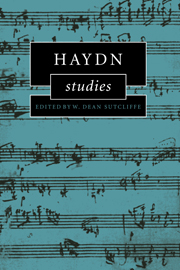Book contents
- Frontmatter
- Contents
- Preface
- Editor's note
- 1 The consequences of presumed innocence: the nineteenth-century reception of Joseph Haydn
- 2 Haydn's sacred vocal music and the aesthetics of salvation
- 3 Sentiment and sensibility in La vera costanza
- 4 Haydn as Romantic: a chemical experiment with instrumental music
- 5 Haydn's ‘Cours complet de la composition’ and the Sturm und Drang
- 6 Haydn's reversals: style change, gesture and the implication-realization model
- 7 Haydn's symphonies between Sturm und Drang and ‘Classical style’: art and entertainment
- 8 The Haydn piano trio: textual facts and textural principles
- 9 Papa Doc's recap caper: Haydn and temporal dyslexia
- 10 Haydn: the musicians' musician
- Index
2 - Haydn's sacred vocal music and the aesthetics of salvation
Published online by Cambridge University Press: 22 September 2009
- Frontmatter
- Contents
- Preface
- Editor's note
- 1 The consequences of presumed innocence: the nineteenth-century reception of Joseph Haydn
- 2 Haydn's sacred vocal music and the aesthetics of salvation
- 3 Sentiment and sensibility in La vera costanza
- 4 Haydn as Romantic: a chemical experiment with instrumental music
- 5 Haydn's ‘Cours complet de la composition’ and the Sturm und Drang
- 6 Haydn's reversals: style change, gesture and the implication-realization model
- 7 Haydn's symphonies between Sturm und Drang and ‘Classical style’: art and entertainment
- 8 The Haydn piano trio: textual facts and textural principles
- 9 Papa Doc's recap caper: Haydn and temporal dyslexia
- 10 Haydn: the musicians' musician
- Index
Summary
Now and then Haydn said that instead of so many quartets, sonatas and symphonies, he should have written more vocal music, for he could have become one of the leading opera composers.
Thus Haydn's biographer Georg August Griesinger transmitted the ageing composer's assessment of his œuvre – the only one of its kind that has come down to us. Although this sentiment appears in the middle of Griesinger's only sustained discussion of Haydn's ideas about his art, it has rarely been taken seriously. The reason is obvious enough: it radically conflicts with the traditional modern focus on the composer's instrumental output – ‘the father of the symphony’, the first great exponent of the string quartet, the master of wit and irony, the hero of ‘Classical style’–a focus that is maintained even in the most interesting recent new approaches to Haydn's music. Among his vocal works, only The Creation and The Seasons, a few Masses and the occasional ‘canzonet’ from the London years have enjoyed much resonance in modern musical life or scholarship; the rest–like his ‘early’ or ‘immature’ instrumental music–has been systematically marginalized.
Yet vocal music constitutes fully half of Haydn's œuvre. Admittedly, during the 1780s and the first half of the 1790s he composed relatively little vocal music (and hardly any sacred music) and his most familiar instrumental works originated precisely during these years. But this emphasis was atypical.
- Type
- Chapter
- Information
- Haydn Studies , pp. 35 - 69Publisher: Cambridge University PressPrint publication year: 1998
- 36
- Cited by

